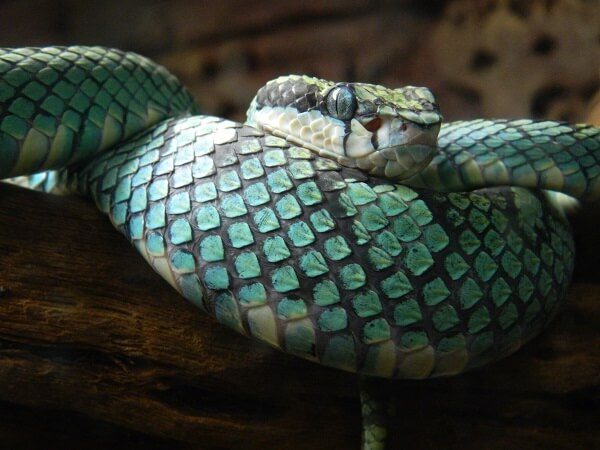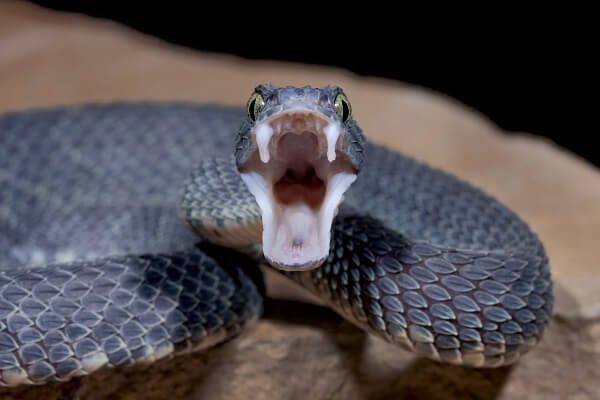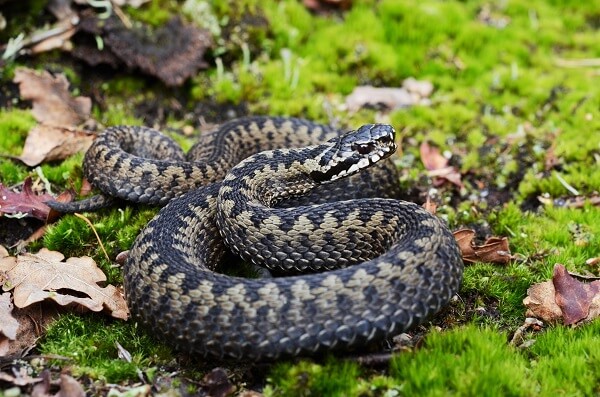
The viper snake is one of over 200 species that belong to the family Viperidae. Species from this large family are found all over the world, except for Antarctica, Australia, north of the Arctic Circle, New Zealand, Madagascar, and some island clusters such as Hawaii. Viper snakes are very diverse and are found in a variety of habitats ranging from mountains to deserts and jungles. The viper snake generally has a large, triangular-shaped head because of large venom glands located behind their eyes. They have short, stocky bodies compared to other snakes, such as cobras and mambas. Although they can often appear sluggish, these short, powerful bodies give them more power to strike and ambush their prey. Vipers are usually camouflaged and blend in with their environment. All species are venomous, although some are more dangerous than others. A viper’s venom is mostly hemotoxic, meaning that it acts on the blood, unlike the venom of elapid species, which is neurotoxic and affects the nervous system. Vipers eat a variety of food depending on the size of the snake. Prey includes small mammals, birds, lizards, and eggs. Vipers will detect their prey through chemical signals and lie in wait until it can ambush it. The viper will inject its venom and let its prey go, waiting for it to die. This method of hunting protects the snake from any damage the prey species might cause it. When their victim is dead, the snakes swallow it whole. Most species of viper are viviparous and give birth to live young. There are a few exceptions to this, including the six species of night adders. There are four subfamilies of the viper snake: Azemiopinae, Causinae, Crotalinae, and Viperinae. Azemiopinae is a subfamily of viper that contains just one genus and two species; Azemiops feae and Azemiops kharini, also known as the Fea’s Viper or mountain viper. These vipers are different from the other vipers in appearance. They have an elliptical-shaped head that has enlarged scales. This genus is so different in appearance from the other viper snake species that it has previously been categorized as belonging to two different families of snakes entirely – the elapid and colubrid families. Scientific research has shown that it is most closely related to the crotaline vipers or pit vipers. It is found in the tropical mountain regions of south-central China, northern Burma, and northern Vietnam. The Causinae subfamily consists of one genus (Causus) and six species that are endemic to sub-Saharan Africa. Commonly known as the night adders, these snakes can grow to around 24 to 36 in long (60 – 90 cm). Unlike most viper snakes, night adders are oviparous, which means that they lay eggs. The snakes lay about 24 eggs at a time, which hatch after four months. These snakes have large venom glands but don’t always inject venom when hunting prey. If a person is bitten by one of these snakes, the venom doesn’t move around the body but does cause localized swelling at the site of the bite. There have been no reports of human death from a night adder bite. Crotalinae is a subfamily of snakes known as pit vipers and includes cottonmouth snakes, copperhead snakes, and rattlesnakes. There are more than 150 species in this subfamily, which are mainly found across North and South Ameria, and in parts of East and Central Asia. This is the only subfamily of viper snakes found in the Americas. Pit vipers are characterized by a heat-sensing pit organ that is located between the eye and the nostril on either side of the head. Many people are afraid of these snakes, but they rarely attack humans and are an essential part of the food chain, feeding on agricultural pests such as rabbits, mice, and rats. The Viperinae subfamily is known as the true vipers and is made up of 12 genera and approximately 66 species. These snakes are found throughout Africa, Asia, and Europe. These vipers lack the heat-sensing pit organ that is found in their sister family, Crotalinae. Common members of this family include puff adders, common European adders, and bush vipers. Viper snakes are a diverse family of snakes that are found in a wide variety of habitats. There are a number of differences between these snakes that make them adapted to their environment and also several biological adaptations that link them. Let’s take a closer look at three of them. Vipers are known for their long, hollow fangs which can fold up and lie against the roof of their mouth. Their fangs connect to venom glands that are located behind the eyes. Venom can travel down from these glands and through the hollow teeth to be injected into the prey animal when the viper bites. One incredible feature of a vipers fangs is that they are rotatable, both together and independently. This means that the snakes can wait until the last second before they bite to erect their fangs. These snakes can open their mouths really wide, up to 180 degrees, which gives them the space to be able to rotate their fangs. When they aren’t in use, the teeth stay folded up in the roof of the snake’s mouth. This means that these fangs can grow relatively long!
Kingdom
Animalia
Phylum
Chordata
Class
Reptilia
Order
Squamata
Family
Viperidae
Subfamily
4
Genus
32
Species
> 200
Length
The smallest is 10 in (25 cm) the largest can reach 10 ft (3 m)
Lifespan
Various
Social Structure
Solitary
Status
Fifty-seven species are near threatened, vulnerable, endangered, critically endangered, or extinct in the wild.
Preferred Habitat
Found in a range of habitats across the world
Average Litter Size
Varies, most species have live young
Main food item
Small mammals, birds, lizards, and eggs.
Main predators
Large mammals and birds.
The Basics

The Four subfamilies of Vipers

Interesting Insights from the Viper Snake.
Hinged Fangs
Hemotoxic Venom
Pit Organ

